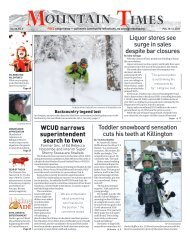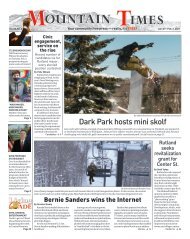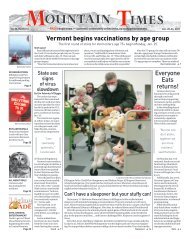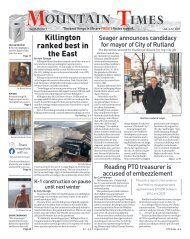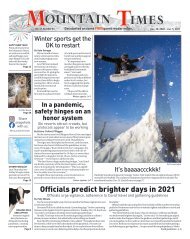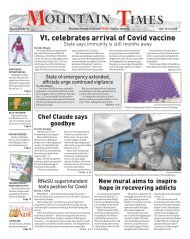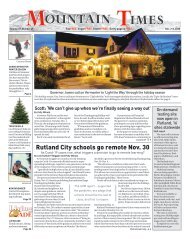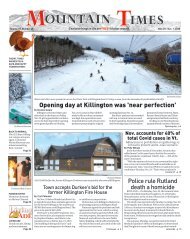Mountain Times - Volume 49, Number 21 - May 20-26, 2020
You also want an ePaper? Increase the reach of your titles
YUMPU automatically turns print PDFs into web optimized ePapers that Google loves.
Columns<br />
24 • The <strong>Mountain</strong> <strong>Times</strong> • <strong>May</strong> <strong>20</strong>-<strong>26</strong>, <strong>20</strong><strong>20</strong><br />
Bats emerge from hibernacula<br />
As spring arrives, so do… bats. Like many<br />
other naturalists, I spend lots of time during this season<br />
looking for migrating salamanders and blossoming<br />
bloodroot. I’ve never thought much about what bats<br />
are doing this time of year. It turns out these flying<br />
mammals, who retreated into hibernation<br />
back in the fall, are emerging from April<br />
through <strong>May</strong>, as the weather grows<br />
consistently warmer and insects again fill<br />
the air.<br />
During summer, bats spend their waking<br />
hours – generally during twilight and dark<br />
– foraging for food. They hunt on the wing,<br />
using echolocation to nab tiny insects, from<br />
agricultural and forest pests to mosquitoes.<br />
Bats eat up to half their body weight daily<br />
and consume literally millions of insects<br />
each summer. As winter sets in and insects<br />
become scarce, six of the nine bat species<br />
in New England seek out hibernacula: caves, mines,<br />
rock crevices, even our attics and barns. Many bats are<br />
susceptible to white nose syndrome during hibernation,<br />
when they share space with hundreds or even many<br />
thousands of bats of various species.<br />
Like other hibernators, including black bears,<br />
bats enter a sleep-heavy torpor state. A bat’s body<br />
temperature may drop to near freezing, and its heart<br />
rate decreases from a rate of <strong>20</strong>0-300 beats per minute<br />
to as low as 10 beats per minute. During hibernation, a<br />
bat cycles through periods of torpor lasting from days<br />
to weeks. This is interrupted by brief periods of arousal,<br />
during which a bat’s temperature rises back to normal<br />
for a few hours.<br />
While occasional emergence from torpor is normal,<br />
however, researchers believe white nose syndrome<br />
causes disruption to hibernation cycles, leading<br />
Flowers give pleasure not only to the one who plants<br />
them but also to those who view<br />
them.<br />
I learned that firsthand recently<br />
on a couple of occasions. A young<br />
local artist, Carrie Pill, asked if she<br />
could paint one of my gardens. It<br />
is near the city sidewalk making it<br />
highly visible to anyone passing by.<br />
Of course, I said, “Yes”! A few days<br />
later Carrie arrived with her easel Looking<br />
and paints. She stationed herself Forward<br />
near the sidewalk and worked By Mary Ellen Shaw<br />
on her creation for about three<br />
hours. I got to see the painting as it progressed. The finished<br />
The Outside<br />
Story<br />
By Olivia Box<br />
affected bats to prematurely expend precious energy<br />
reserves they need to survive the winter. First identified<br />
in a cave near Albany, New York, in <strong>20</strong>07, white nose<br />
syndrome has expanded to bat colonies in nearly half<br />
of U.S. states and parts of Canada. This fungal disease<br />
spreads easily and has decimated bat populations in the<br />
Northern Hemisphere.<br />
Because the fungus can remain in a cave even after<br />
bats are gone, it is transmissable between colonies.<br />
The fungus grows on the skin of bats and it makes them<br />
more likely to wake early and erratically. As they burn<br />
through their fat reserves, bats can starve and die. All<br />
six cave bats living in New England are now state-level<br />
or federally endangered. Populations of the little brown<br />
bat and northern long eared bat have declined 90% due<br />
in large part to white nose syndrome.<br />
Bats that are able to survive white nose syndrome<br />
during hibernation may recover during the summer,<br />
when high temperatures kill the fungus. According<br />
to Katherine Ineson, a PhD candidate and wildlife<br />
biologist at the University of New Hampshire who<br />
studies white nose syndrome in the Northeast, “The<br />
fungus damages their wings. But unless the damage is<br />
extreme, the bats are able to clear the infection and heal<br />
their wings within several weeks of emerging<br />
from hibernation.”<br />
Female bats generally leave hibernacula<br />
earlier than males, who emerge shortly after<br />
and aren’t involved in raising pups. During<br />
spring and summer, female bats gather in<br />
maternal colonies, congregating in trees,<br />
attics, or barns. Summer colony size varies<br />
by species and location. Little brown bat<br />
colonies may number in the thousands,<br />
while other colonies, particularly bats that<br />
roost in trees, typically contain fewer than<br />
100 bats.<br />
Although bats from most species mate<br />
in the fall, females are able to store sperm and delay<br />
fertilization until spring. Each female typically gives<br />
birth to a single pup. Pups are able to fly when they are<br />
about a month old, but continue to use the maternal<br />
roost as they learn to forage on their own.<br />
I have yet to see a bat silhouette moving quickly<br />
across a dusky sky this spring, but I’ve added them to<br />
my list of things to look for during this season. Their<br />
presence – while so fleeting in the night –is a welcome<br />
one.<br />
Olivia Box is a freelance writer and a graduate student<br />
at the University of Vermont, studying forests threatened<br />
by climate change and invasive pests. The illustration for<br />
this column was drawn by Adelaide Tyrol. The Outside<br />
Story is assigned and edited by Northern Woodlands<br />
magazine and sponsored by the Wellborn Ecology Fund<br />
of New Hampshire Charitable Foundation: nhcf.org.<br />
product is now hanging in our home as I feel that’s where it<br />
belongs!<br />
Carrie thanked me for the inspiration that came to her<br />
each time she walked or rode past the garden.<br />
Another experience with a stranger enjoying this same<br />
garden came when I was sitting tucked away behind a<br />
nearby fence reading my book. I heard some young voices<br />
and then that of an adult male telling the children to walk<br />
carefully down to the hyacinths, which are just a few feet<br />
from the sidewalk, and smell them. My first reaction was<br />
one of surprise because most men would have no idea what<br />
that flower is. My husband wouldn’t have a clue and he has<br />
watched me plant gardens for 45 years! With youngsters<br />
being schooled from home these days their experience with<br />
my flowers could qualify as a lesson in botany. They learned<br />
Life as we know it has changed dramatically during <strong>20</strong><strong>20</strong>.<br />
As the coronavirus spread across the United States, cities<br />
and states issued shelter-in-place<br />
orders to slow the spread of the<br />
coronavirus and prevent healthcare<br />
facilities from being overwhelmed<br />
by critically ill patients.<br />
In <strong>May</strong>, when states started<br />
to reopen, Americans began to<br />
return to work with eagerness and<br />
Money<br />
Matters<br />
By Kevin Theissen<br />
The pleasure of flowers<br />
Life and finances in<br />
a pandemic world<br />
trepidation. Many were happy<br />
to leave isolation and reconnect<br />
with friends and colleagues at a<br />
safe social distance. However, they<br />
were also concerned about being<br />
exposed to the coronavirus.<br />
American workplaces tend to feature shared workspaces,<br />
shared desks, shared equipment, and shared bathrooms.<br />
We share a lot at work. Since no one wants to share<br />
SARS-CoV-2, the virus that causes Covid-19, companies<br />
have been encouraged to adopt new policies and procedures<br />
that will protect workers.<br />
Implementing workplace social protections<br />
The Centers for Disease Control and Prevention (CDC)<br />
and the Department of Labor (DOL) have issued guidance<br />
for employers who are preparing for employees to return<br />
to work. Both recommend businesses develop infectious<br />
disease preparedness plans. Sound plans will identify<br />
where and how employees may be exposed to the virus and<br />
then take steps to prevent exposure. The guidance issued<br />
recommends:<br />
• Organizing flexible worksites and work hours to<br />
ensure social distancing<br />
• Discouraging sharing of offices, desks, work tools,<br />
and/or equipment<br />
• Implementing routine deep cleaning and sanitization<br />
of workspaces<br />
• Providing personal protective equipment when<br />
people work in close proximity<br />
• Requiring workers to wear masks<br />
• Making hand sanitizer readily available in many<br />
locations<br />
• Establishing and encouraging handwashing breaks<br />
• Creating isolation areas for employees who show<br />
symptoms<br />
Embracing new approaches to work<br />
Some employers may encourage some employees to<br />
continue to work from home because they have discovered<br />
it improved productivity. For instance, 53,000 employees<br />
of the Social Security Administration have been working<br />
from home. Statistics show the agency has been processing<br />
claims for new benefits and appeals at a faster pace than<br />
Money matters > 27<br />
firsthand the name of the flower and its scent. <strong>May</strong>be some<br />
future gardeners were born that day!<br />
I purposely placed the hyacinths close to the sidewalk<br />
as they have a lovely fragrance and I wanted passersby to<br />
enjoy that experience. Apparently my theory is working!<br />
There have been numerous people who have pulled<br />
out their cell phones and snapped pictures of this garden<br />
from the sidewalk. My guess is that when they look at their<br />
photos they will see a sign of peace and hope in this topsyturvy<br />
world. The garden is about 50 feet long with yellow<br />
daffodils and pink, purple and blue hyacinths providing a<br />
sea of color. With this spring’s cool weather these flowers<br />
lasted longer than usual.<br />
As I age I wonder if it’s worth the effort to plant 100 or<br />
more bulbs every fall. I don’t think I will have any doubts<br />
Looking forward > 27





